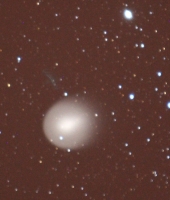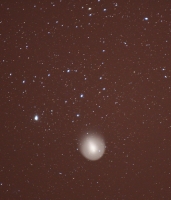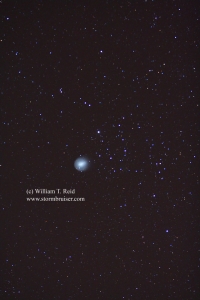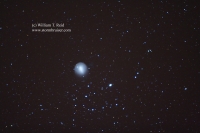 I became aware of Comet Holmes several days ago. It brightened suddenly from magnitude 17 to about magnitude 2.5 on October 25th. I had Tuesday evening (Nov. 13) off from work, the weather was warm and clear, there was no light interference from the moon, and the comet was in Perseus and rising high in the northeast sky. I couldn’t think of a good excuse NOT to spend some time checking out the comet and taking its picture. It had been quite a while since I had done some astro-photography, perhaps not since the Dodgers hosted Houston in a one-game playoff back in 1980.
I became aware of Comet Holmes several days ago. It brightened suddenly from magnitude 17 to about magnitude 2.5 on October 25th. I had Tuesday evening (Nov. 13) off from work, the weather was warm and clear, there was no light interference from the moon, and the comet was in Perseus and rising high in the northeast sky. I couldn’t think of a good excuse NOT to spend some time checking out the comet and taking its picture. It had been quite a while since I had done some astro-photography, perhaps not since the Dodgers hosted Houston in a one-game playoff back in 1980.
The comet was easily visible from my porch in Westlake Village in the early evening. It was a little fuzz ball, like a round white cotton ball or a big out-of-focus star. I decided to find a darker area, so I lugged my 8-inch Celestron and camera equipment into the Santa Monica Mountains to the south. I drove for about 15 minutes and found a wide turnout along Latigo Canyon Road, east of Kanan-Dume Road, well removed from any nasty street lights and civilization. The elevation here was about 2000 feet. There was a light breeze, no clouds, low humidity, and a wonderful temperature of 68F. The sky was dark, but not really dark. Mountain ridges to the north and east helped a little to block the light pollution from the San Fernando Valley and Los Angeles. The Milky Way was dimly visible, and Comet Holmes was about halfway up from the northeastern horizon.
I set up the telescope, and the comet almost filled up the field of view afforded by the 40mm eyepiece. The comet had a bright midsection and a dimmer halo surrounding it, but a sharp outline or outer boundary to the “halo”. To photograph the comet, I needed to align the telescope to due north and plug in the clock drive to the X-terra’s DC outlet. This would help to keep star trails to a minimum as the telescope compensated for the earth’s rotation. I don’t have the equipment (yet) to take photographs “through” the scope with my Rebel XT digital camera, so I mounted the camera onto the top of the Celestron. This is called “piggybacking.” The camera will move with the telescope and its clock drive, so I could take exposures of several minutes or more if I wanted to without star trails (or blurry comet trails).
I had the Canon 70-200mm zoom 2.8 lens attached. It is a beast, and I had to stick a counterbalance weight onto the opposite side of the scope to keep it happy. I took a total of about 50 exposures of the comet, and a few of the Pleiades. I knew that if I was going to have photo problems, then it would be due to focusing issues. The exact spot for infinity on the lens is an extremely precise position. I zoomed in on a bright star (Capella) several times during the two-hour session to make sure that the lens was focused as perfectly as possible. Still, there were some shots which were out of focus. I played around at 400, 800, and 1600 ISO, and shot mostly at 800. The lens was kept wide open at 2.8, and I shot exposures ranging from about 15 seconds to two minutes. I found that at 800 ISO, the background sky began to become too bright or washed out for exposures of a minute or more. Despite the rudimentary “eyeballing” of the telescope mount for setup, the scope followed the stars well and there was minimal drifting. At full zoom (at 200mm, an equivalent of 320mm with the Rebel XT), the comet wasn’t particularly large, but it stood out prominently in the star field.
Several of the best shots are below, with a crop and zoom-in for one of them. On the camera’s display screen, the star colors were stark and impressive. The star colors on my laptop screen seem muted and dull. Hmmm.




Leave a Reply
You must be logged in to post a comment.